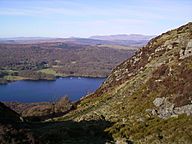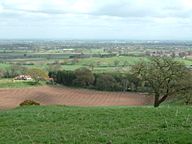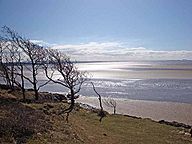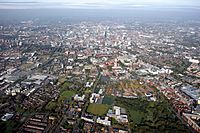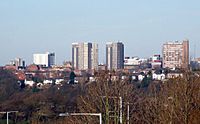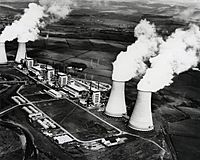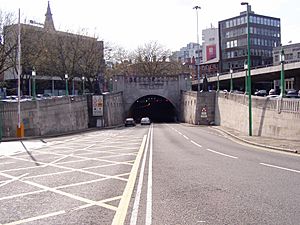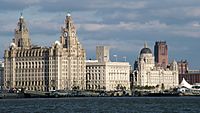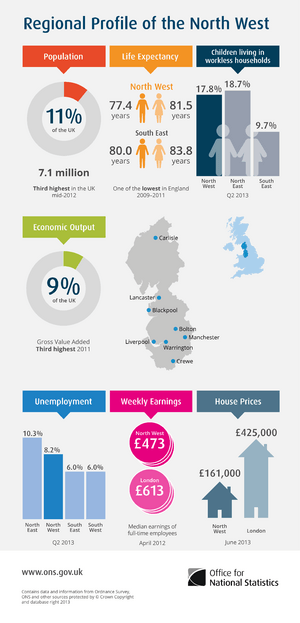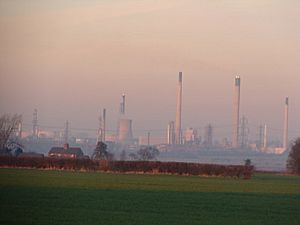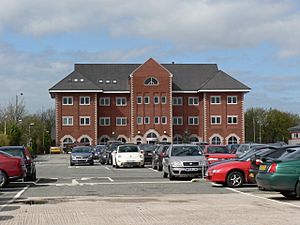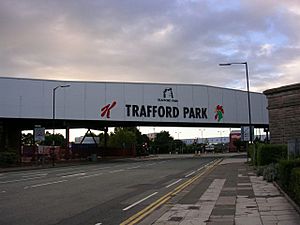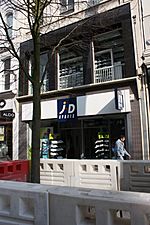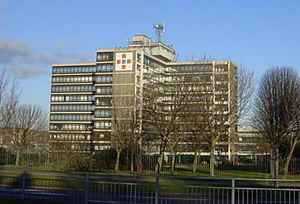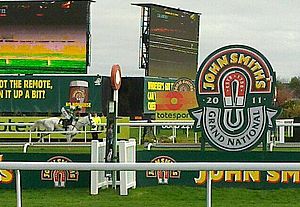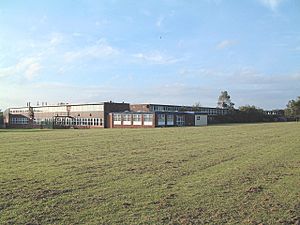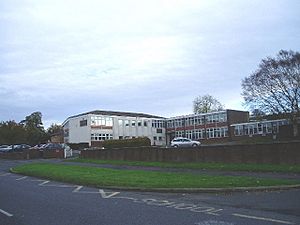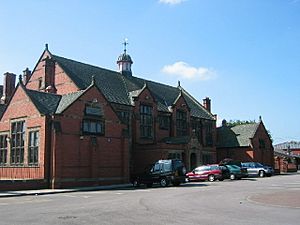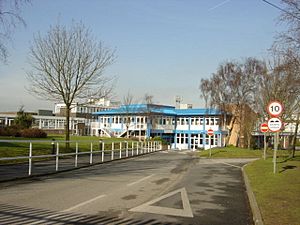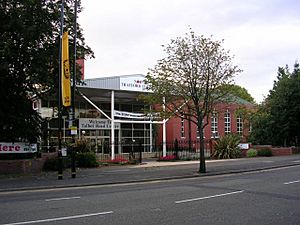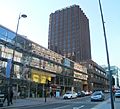North West England facts for kids
Quick facts for kids
North West England
|
|
|---|---|
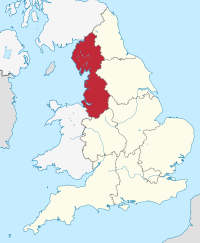 |
|
| Sovereign state | United Kingdom |
| Constituent country | England |
| Largest city | Manchester |
| Largest urban area | Greater Manchester Built-up Area |
| Area | |
| • Total | 5,469 sq mi (14,165 km2) |
| Area rank | 6th |
| Population
(2011)
|
|
| • Total | 7,052,000 |
| • Rank | 3rd |
| • Density | 1,290/sq mi (497/km2) |
| GVA | |
| • Total | £231 billion |
| • Per capita | £18,438 (5th) |
| ITL code | TLD |
| ONS code | E12000002 |
North West England is a big and important area in England. It's one of nine official regions. This region includes the areas of Cheshire, Cumbria, Greater Manchester, Lancashire, and Merseyside. In 2011, about 7 million people lived here. This makes it the third most populated region in the United Kingdom. Only the South East and Greater London have more people. The two biggest cities in the North West are Manchester and Liverpool.
Contents
- Exploring the Geography of North West England
- People and Places: Demographics of the North West
- Cities and Towns in the North West
- A Look Back: History of the North West
- Getting Around: Transport in the North West
- Global Connections: Town and City Twinnings
- Weather in the North West
- Economy: How the North West Makes Money
- Sports in the North West
- Learning and Growing: Education in the North West
- Images for kids
- See also
Exploring the Geography of North West England
North West England has a varied landscape. To the east, you'll find the Peak District and the Pennines mountains. To the west is the Irish Sea. The region stretches from the Scottish Borders in the north down to the West Midlands in the south. North Wales is to its southwest.
Some of the most famous natural features include the beautiful Lake District and the flat Cheshire Plain. The highest point in North West England is Scafell Pike in Cumbria. It's also the highest mountain in all of England, standing at 3,209 feet (978 meters).
Windermere is the largest natural lake in England. Broad Crag Tarn is England's highest lake. Wast Water is the deepest lake in England, reaching 74 meters (243 feet) deep.
The region has both countryside and busy cities. Two large urban areas, around Liverpool and Manchester, cover much of the south. The northern part, including Cumbria and northern Lancashire, is mostly rural. The far south, with parts of the Cheshire Plain and Peak District, is also very rural.
The North West includes parts of three National Parks. These are all of the Lake District, and small parts of the Peak District and the Yorkshire Dales. It also has three Areas of Outstanding Natural Beauty. These are all of Arnside and Silverdale and the Solway Coast, and almost all of the Forest of Bowland.
People and Places: Demographics of the North West
How Many People Live Here?
The North West is home to about 13% of England's total population. Most people live in the larger urban areas. For example, over a third of the region's population lives in Greater Manchester.
| Region/County | Population | Population Density | Largest town/city | Largest urban area |
|---|---|---|---|---|
| Greater Manchester | 2,629,400 | 2,016/km2 | Manchester (510,700) (2012 est.) | Greater Manchester Urban Area (2,240,230) |
| Lancashire | 1,449,600 | 468/km2 | Blackpool (147,663) | Preston/Chorley/Leyland Urban Area (335,000) |
| Merseyside | 1,353,600 | 2,118/km2 | Liverpool (491,500) | Liverpool Urban Area (816,000) |
| Cheshire | 1,003,600 | 424/km2 | Warrington (202,228) | Warrington (202,228) |
| Cumbria | 496,200 | 73/km2 | Carlisle (71,773) | Carlisle (71,773) |
A Mix of Cultures: Ethnicity in the North West
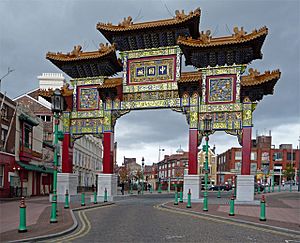
The North West is a very diverse region. Cities like Manchester and Liverpool are among the most diverse in Europe. In 2009, about 91.6% of people in the region identified as 'White'. This includes people of White British and White Irish backgrounds.
Many Welsh people moved to the North West during the Industrial Revolution to work in coal mines. Because of this, areas like Liverpool and Chester have many people with Welsh family roots.
About 1.3% of the population is of Mixed Race. Around 4.7% are South Asian, and 1.1% are Black. There are also significant Chinese communities, especially in Liverpool, which has the oldest Chinatown in Europe.
For example, in Blackburn with Darwen, nearly 20% of the population is Muslim. In contrast, towns like St. Helens in Merseyside have very few ethnic minorities, with 98% identifying as White British.
Where People Come From: Place of Birth
Many people living in the North West were born in other countries. This adds to the region's rich cultural mix. After England, the most common birthplaces for people in the North West include Scotland, Wales, Ireland, Pakistan, and India.

Faith and Beliefs: Religion in the North West
Most people in the North West identify as Christian. The region also has significant Muslim, Hindu, and Jewish communities. About 26% of the population reported having no religion or did not state one in the 2011 UK Census.
| Region | Christian | Muslim | Hindu | Sikh | Jewish | Buddhist | Other | No Religion/ Not Stated |
|---|---|---|---|---|---|---|---|---|
| North West England | 67.3% | 5.1% | 0.5% | 0.1% | 0.4% | 0.3% | 0.3% | 26.0% |
| England | 59.4% | 5.0% | 1.5% | 0.8% | 0.5% | 0.5% | 0.4% | 31.9% |
Many people in the North West are Catholic. This is partly due to many Irish people moving here in the 1800s.
Understanding Social Deprivation
Even though the North West has a good economy, some areas face more challenges. Wealth is mostly found in very rich areas like rural Cheshire and Cumbria. Some areas have more signs of poverty than others.
The most challenged areas include Liverpool, Manchester, and Blackpool. In contrast, places like Eden and Ribble Valley have very low unemployment rates.
Cities and Towns in the North West
The North West is home to many important cities and towns. Here are some of the largest:
- GM = Greater Manchester, ME = Merseyside, CU = Cumbria, LA = Lancashire, CH = Cheshire
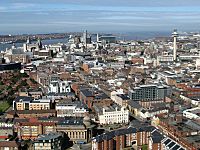

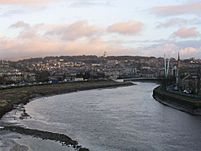

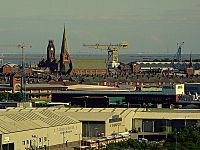
Population > 400,000
- Manchester, GM
- Liverpool, ME
Population > 100,000
- Warrington, CH
- Blackpool, LA
- Stockport, GM
- Sale, GM
- Bolton, GM
- Preston, LA
- Rochdale, GM
- Blackburn, LA
- Wigan, GM
- St. Helens, ME
- Wythenshawe, GM
Population > 70,000
- Oldham, GM
- Southport, ME
- Birkenhead, ME
- Chester, CH
- Bury, GM
- Bootle, ME
- Carlisle, CU
- Northwich, CH
- Burnley, LA
- Crewe, CH
- Salford, GM
Population > 50,000
- Runcorn, CH
- Widnes, CH
- Wallasey, ME
- Barrow-in-Furness, CU
- Ellesmere Port, CH
- Altrincham, GM
- Macclesfield, CH
- Crosby, ME
- Leigh, GM
Population > 30,000
- Accrington, LA
- Lancaster, LA
- Ashton-under-Lyne, GM
- Middleton, GM
- Lytham St Annes, LA
- Urmston, GM
- Kirkby, ME
- Skelmersdale, LA
- Eccles, GM
- Stretford, GM
- Denton, GM
- Leyland, LA
- Chadderton, GM
- Morecambe, LA
- Chorley, LA
- Hyde, GM
- Huyton, ME
- Thornton-Cleveleys, LA
- Prestwich, GM
- Saddleworth, GM
- Winsford, CH
- Farnworth, GM
Population > 20,000
- Radcliffe, GM
- Nelson, LA
- Ashton-in-Makerfield, GM
- Kendal, CU
- Heywood, GM
- Reddish, GM
- Darwen, LA
- Hindley, GM
- Cheadle Hulme, GM
- Fleetwood, LA
- Congleton, CH
- Swinton, GM
- Workington, CU
- South Turton, GM
- Westhoughton, GM
- Wilmslow, CH
- Ormskirk, LA
- Golborne, GM
- Whitehaven, CU
- Stalybridge, GM
- Marple, GM
- Whitefield, GM
- Droylsden, GM
- Penwortham, LA
- Formby, ME
- Litherland, ME
- Newton-le-Willows, ME
- Atherton, GM
- Rawtenstall, LA
- Royton, GM
- Walkden, GM
- Shaw and Crompton, GM
- Failsworth, GM
- Maghull, ME
- Halewood, ME
- Horwich, GM
Population > 10,000
- Irlam, GM
- Dukinfield, GM
- Colne, LA
- Poulton-le-Fylde, LA
- Sandbach, CH
- Ramsbottom, GM
- Moreton, ME
- Bramhall, GM
- Nantwich, CH
- Haslingden, LA
- Upton, ME
- Hazel Grove, GM
- Clitheroe, LA
- Tyldesley, GM
- Romiley, GM
- Pendlebury, GM
- Woodley, GM
Population > 5,000
- Gatley, GM
Big City Areas: Metropolitan Areas
The five largest metropolitan areas in the North West are:
- Greater Manchester metropolitan area – 2,556,000 people
- Liverpool/Birkenhead metropolitan area – 2,241,000 people
- Blackburn/Burnley – 391,000 people
- Preston – 354,000 people
- Blackpool – 304,000 people
Liverpool and Manchester are sometimes seen as part of one huge urban area. However, they are usually treated as separate big city regions.
A Look Back: History of the North West
The North West has a rich history, especially in science and industry.
Amazing Inventions and Discoveries
The North West has been a hub for scientific breakthroughs.
- In 1909, Sir Ernest Marsden and Hans Geiger worked at the University of Manchester. They invented the Geiger counter, which showed that atoms have a central part called a nucleus.
- Sir J. J. Thomson from Cheetham Hill discovered the electron in 1897. He won a Nobel Prize for this.
- John Dalton, from Cumbria, developed the atomic theory, which explains how everything is made of tiny particles.
- William Sturgeon of Lancashire invented the electromagnet in 1825.
- In 2004, Graphene was discovered at the University of Manchester by Professor Sir Andre Geim and Sir Konstantin Novoselov. Graphene is a super-strong and thin material.
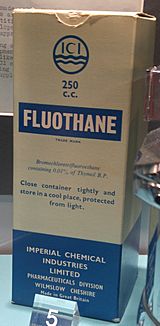
Many important materials were also invented here:
- In 1941, John Rex Whinfield and James Tennant Dickson discovered polyethylene terephthalate (PET) in Manchester. This is a common plastic used in bottles.
- Polythene, a widely used plastic, was discovered in 1933 at an ICI lab in Northwich.
- Halothane, the first synthetic gas for general anaesthesia, was discovered in 1951 in Widnes.
- Sir John Charnley of Bury invented the hip replacement in 1962.
Industrial Powerhouse: The North West's Industrial Past
The North West played a huge role in the Industrial Revolution.
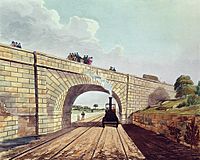
- The Liverpool and Manchester Railway opened in 1830. It was the world's first passenger railway between two cities. Manchester Liverpool Road railway station is the oldest surviving railway station in the world.
- The Bridgewater Canal was the first modern canal, built in 1761. It helped transport coal from mines to Manchester.
- The Spinning Jenny, a machine that made spinning yarn much faster, was invented in Lancashire in 1764 by James Hargreaves.
The region also led the way in computing:
- The University of Manchester built the world's first programmable computer, the Manchester Baby, in 1948.
- The first computer memory, the Williams–Kilburn tube, was also developed here.
- The first computer sold commercially, the Ferranti Mark 1, was made in Manchester in 1951.
Other key industrial facts:
- Alastair Pilkington invented the float glass method in 1957 in St Helens. This method is now used to make 80% of the world's glass.
- Pears soap, made at Port Sunlight, is the world's first registered brand.
- Sebastian Ziani de Ferranti from Liverpool designed the first alternating current power station in the world in 1887. This design is still used today for electricity networks.
- Calder Hall was the world's first nuclear power station, opening in 1956.
- Britain's first nuclear bomb was made using plutonium from Windscale (now Sellafield) in 1952.
- The Ford Escort, a very popular car, was made at the Halewood factory by Ford until 2000. Now, Jaguar Land Rover makes cars there.
Culture and Heritage
- The Suffragette movement, which fought for women's right to vote, started in Manchester with the Women's Social and Political Union (WSPU).
- Arthur Wynne, born in Liverpool, invented the crossword puzzle in 1913.
- The UK's second and third public libraries opened in Warrington (1848) and Salford (1850).
- The first Trades Union Congress was held in Manchester in 1868.
- The World Pie Eating Championship is held every year in Wigan!
- Jelly Babies were invented in Lancaster in 1864.
- The first KFC restaurant in the UK opened in Preston in 1965.
- Oldham claims to be where fried potatoes were first served in the UK in 1860.
- The International Cheese Awards are held in Nantwich every July.
- Liverpool and Manchester are famous for their music. Liverpool was the birthplace of "Merseybeat" music in the 1960s (think The Beatles). Manchester developed the "Madchester" music scene in the 1980s and 90s.
Getting Around: Transport in the North West
The North West has a well-developed transport system, including roads, airports, and railways.
Roads: Driving Through the Region
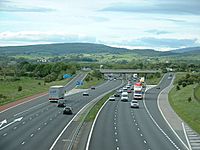
The main road in the North West is the M6. It runs from Scotland in the north, through cities like Carlisle, Lancaster, Preston, and Warrington, before heading south towards the Midlands. This motorway is very busy, carrying almost 120,000 vehicles every day.
In Greater Manchester and Merseyside, there's a large network of motorways. The M62 connects Manchester and Liverpool. The M60 is Manchester's ring road.
Cumbria has roads like the A590 and A595 that connect its towns and coastal areas. Lancashire also relies on the M6, and has the M55 connecting Preston to Blackpool. Cheshire has the M6, M56, M53, and M62 motorways.
Airports: Flying In and Out
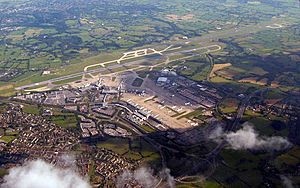

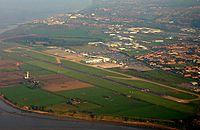
The biggest airport in the region is Manchester Airport. It serves over 28 million passengers each year, flying to destinations all over the world. It has three terminals and is a major hub for many airlines.
The second largest airport is Liverpool John Lennon Airport. It serves over 5 million passengers annually, mainly flying to places in the UK and Europe. It's a major hub for EasyJet and Ryanair.
Railways: Traveling by Train
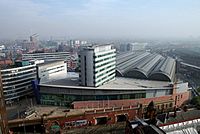
The main train line is the West Coast Main Line, which connects most of the North West. There are also important lines connecting Liverpool to Manchester. Both Liverpool and Manchester have large local train networks for commuters.
The first InterCity train service in the UK started between London and Manchester in the 1960s. The North West also saw the very last steam-train service on the UK network in 1968.
Waterways: Ferries and Canals
You can catch ferries from the Port of Liverpool to places like Dublin and the Isle of Man. Ferries also depart from Birkenhead and Fleetwood.
The Leeds and Liverpool Canal now runs right into Liverpool city centre. The Liverpool Cruise Terminal offers long-distance cruises to places like Iceland, France, and Norway.
Global Connections: Town and City Twinnings
Many towns and cities in the North West have "twin" towns or cities in other countries. This helps build friendships and cultural exchange between different places around the world.
| Ashton-under-Lyne | |
| Blackburn | |
| Blackpool | |
| Bolton | |
| Burnley | |
| Bury | |
| Carlisle | |
| Carnforth | |
| Chadderton | |
| Chester | |
| Chorley | |
| Dalton-in-Furness | |
| Denton | |
| Droylsden | |
| Dukinfield | |
| Ellesmere Port | |
| Failsworth | |
| Fleetwood | |
| Halton | |
| Heywood | |
| Kendal | |
| Knowsley | |
| Lancaster | |
| Liverpool | |
| Longdendale | |
| Manchester | |
| Mossley | |
| Oldham | |
| Oswaldtwistle | |
| Preston | |
| Rochdale | |
| Salford | |
| Sedbergh | |
| Sefton | |
| Stalybridge | |
| Stockport | |
| St. Helens | |
| Tameside | |
| Ulverston | |
| Warrington | |
| Whitehaven | |
| Wigan | |
| Workington | |
| Wrea Green |
Weather in the North West
The North West generally has typical UK weather. Temperatures are usually close to the national average. Cumbria often gets the most extreme weather. This is because of the high mountains in the Lake District and Pennines, which receive a lot of rain and snow.
In winter, the highest and most open areas experience the coldest and snowiest conditions. Parts of the North West had a White Christmas in both 2009 and 2010.
Economy: How the North West Makes Money
Historically, the North West was famous for its textiles industry. Today, the economy is very diverse. Greater Manchester produces the most economic output in the region. Merseyside, Lancashire, Cheshire, and Cumbria also contribute significantly.
Experts say that Manchester is one of the best cities in the UK for businesses. The North West economy, especially in Manchester and Liverpool, is seen as a strong competitor to London.
The Morecambe Bay gas field provides about 6% of the UK's natural gas.
Cheshire's Economy
Cheshire has a strong connection to the salt industry. Large companies like AstraZeneca (a pharmaceutical company) have manufacturing sites here. Vauxhall makes cars in Ellesmere Port. The Essar Energy refinery is one of the UK's largest oil refineries.
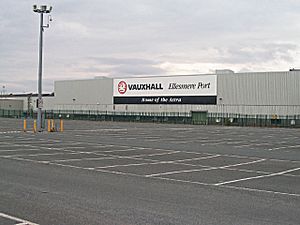
Bentley Motors has its main car plant in Crewe. Tata Chemicals Europe and British Salt are important chemical and salt companies in the area. Winsford is home to the UK's largest salt mine.
Runcorn is a major site for Ineos Fluor, which produces chlorine and other chemicals. United Utilities, a large water company, is based in Warrington. Unilever makes famous washing powders like Persil and Surf in Warrington.
Lancashire's Economy
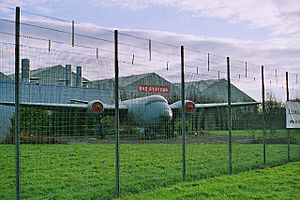
Lancashire is a key area for the aerospace industry. BAE Systems Military Air & Information has large sites near Preston, where they make parts for military aircraft like the Eurofighter. Rolls-Royce makes turbofan blades in Barnoldswick.
Other important companies include BAXI (boilers) in Preston and AB InBev (brewery) in Samlesbury. Brands like Reebok and Warburtons (famous for bread) started in Lancashire. Leyland Trucks manufactures trucks in Leyland.
Victrex makes special plastics in Cleveleys. Crown Paints is based in Darwen. Graham & Brown and CWV make wallpaper in Blackburn.
Greater Manchester's Economy
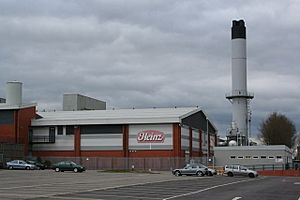
Greater Manchester has a very strong and diverse economy. Joseph Holt's Brewery is in Manchester. PZ Cussons (known for soap and personal care products) has a manufacturing site in Salford.
Wigan is home to Heinz, which has one of the largest food processing complexes in Europe. They produce billions of cans of food each year. Other companies in Wigan include JJB Sports and Shearings Holidays.
In Bolton, Warburtons (a major bakery) has its head office. MBDA makes missiles in Lostock. Watson Steel Structures in Lostock built parts of the Olympic Stadium and other famous steel structures.
Stockport is home to NXP Semiconductors (electronics) and Adidas UK. McVitie's makes popular biscuits like Jaffa Cakes and chocolate digestives in South Manchester.
Kelloggs has a large factory in Trafford Park, Manchester, producing cereals. The Peel Group, a property and transport company, is also based near the Trafford Centre. The Co-op is based in Manchester and Rochdale. Minky Homecare (household cleaning products) is in Rochdale. Guenther Bakeries in Heywood makes bread buns for McDonald's.
JD Sports, a major sports fashion retailer, is based in Bury.
Merseyside's Economy
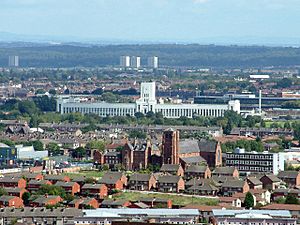
Merseyside has a strong economy, especially around Liverpool. Pilkington (glass manufacturing) is in St. Helens. Vimto, a popular soft drink, is owned by Nichols plc of Newton-le-Willows.
Many companies have their headquarters in Liverpool, including Princes (food and drink), Johnsons Cleaners UK, Maersk Line UK (shipping), and Home Bargains (retail). Jacob's (crackers) and Twiglets are made in Fazakerley.
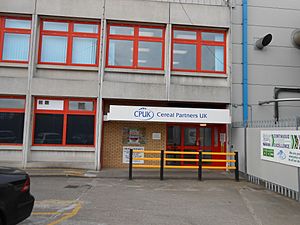
Jaguar Land Rover has a large car production site in Halewood. Halewood International makes drinks like Lambrini. Belling Ltd in Whiston is the UK's only manufacturer of cookers. Matalan, a fashion retailer, has its head office in Knowsley.
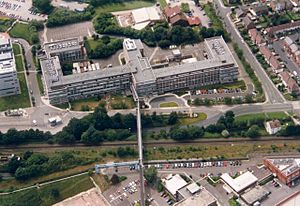
In Port Sunlight, Unilever makes and researches detergents and shampoos. Cammell Laird in Birkenhead builds ships. Typhoo tea is made in Moreton.
The HSE (which looks after safety at work) has its head office in Bootle.
Cumbria's Economy
Cumbria's economy is strongly linked to energy and tourism. BAE Systems Submarine Solutions in Barrow-in-Furness builds submarines and ships for the Royal Navy. The coast of Cumbria is known as Britain's Energy Coast. This is because of power stations like Sellafield and offshore wind farms like Walney Wind Farm.
Lakeland, which makes kitchenware, is based in Windermere. Stobart Group, a transport and logistics company, is in Carlisle. The Lake District is very popular with tourists, bringing many visitors to the area.
Sports in the North West
The North West is a big area for sports. The modern dart board was invented in 1896 by a carpenter from Bury. Oulton Park in Cheshire hosts car racing events like the British Touring Car Championship. Manchester is home to the National Cycling Centre (with the Manchester Velodrome) and the National Football Museum.
Football: A Passionate Region
The North West is famous for its football teams. Many top clubs are based here. Teams from the North West have won 60 out of 120 English football League titles, which is more than any other region! Manchester United has won more titles than any other team.
Rugby League: Strong Teams in the North West
The North West is also a major area for rugby league. Many strong clubs compete in the top leagues.
Super League Teams
- Leigh Centurions (Leigh, Greater Manchester)
- Salford City Reds (Salford, Greater Manchester)
- St. Helens (St Helens, Mersyside)
- Warrington Wolves (Warrington, Cheshire)
- Wigan Warriors (Wigan, Greater Manchester)
Championship Teams
- Swinton Lions (Swinton, Greater Manchester)
- Oldham Roughyeds (Oldham, Greater Manchester)
- Whitehaven (Whitehaven, Cumbria)
- Widnes Vikings (Widnes, Cheshire)
League 1 Teams
- Barrow Raiders (Barrow-in-Furness, Cumbria)
- Rochdale Hornets (Rochdale, Greater Manchester)
- Workington Town (Workington, Cumbria)
Golf: Famous Courses
The North West has several famous golf courses. These include Royal Birkdale Golf Club at Southport, Royal Lytham & St Annes Golf Club, and Royal Liverpool Golf Club at Hoylake.
Learning and Growing: Education in the North West
The North West has many schools and universities.
Secondary Schools: Learning for Teens
Most secondary schools in the region are comprehensive schools. However, Trafford still has a selective school system, meaning students take an exam to get in. There are also some grammar schools in Lancashire, Wirral, Liverpool, and Cumbria.
About 345,000 students attend secondary school in the North West. This is the third highest number in England. Areas like Trafford and Cheshire have very good school results.
Some of the top-performing grammar schools include:
- Altrincham Grammar School for Girls
- Altrincham Grammar School for Boys
- The Blue Coat School, Liverpool
- Lancaster Girls' Grammar School
- The Blue Coat CofE School, Oldham
- Wirral Grammar School for Girls
- Wirral Grammar School for Boys
- Loreto Grammar School, Altrincham
- West Kirby Grammar School
- Clitheroe Royal Grammar School
Students from Trafford and Cheshire are most likely to go to university.
Colleges: Further Education Opportunities
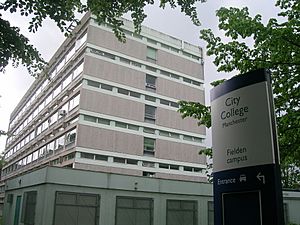
The North West has many colleges offering further education. These colleges provide a range of courses for students after secondary school.
Some of the colleges in the region include:
- Aquinas College, Stockport
- Ashton Sixth Form College, Ashton-under-Lyne
- Barrow-in-Furness Sixth Form College, Barrow-in-Furness
- Blackburn College, Blackburn
- Blackpool and The Fylde College, Blackpool
- Blackpool Sixth Form College, Blackpool
- Bolton College, Bolton
- Bolton Sixth Form College, Bolton
- Burnley College, Burnley
- Bury College, Bury
- Carlisle College, Carlisle
- Carmel College, St Helens
- Cheadle and Marple Sixth Form College, Cheadle
- Furness College, Barrow-in-Furness
- Hazel Grove High School Sixth Form, Stockport
- Holy Cross College (UK), Bury
- Hopwood Hall College, Rochdale
- Hugh Baird College, Bootle
- Kendal College, Kendal
- King George V College, Southport
- Lancaster and Morecambe College, Lancaster
- Liverpool Community College, Liverpool
- Loreto College, Manchester
- Macclesfield College, Macclesfield
- The Manchester College, Manchester
- Mid Cheshire College, Northwich
- The Oldham College, Oldham
- Oldham Sixth Form College, Oldham
- Preston College, Preston
- Priestley College, Warrington
- Rainford College, St Helens
- Riverside College, Widnes
- Runshaw College, Leyland
- Salford City College, Salford
- South Cheshire College, Crewe
- Southport College, Southport
- Sir John Deane's College, Northwich
- Stockport College, Stockport
- St Helens College, St Helens
- St John Rigby College, Wigan
- St. Mary's College, Blackburn
- St. Wilfrids C of E Sixth Form College, Blackburn
- Thomas Whitham Sixth Form, Burnley
- Trafford College, Trafford
- West Cheshire College Ellesmere Port
- Wigan and Leigh College, Wigan
- Winstanley College, Wigan
- Xaverian College, Manchester
Universities: Higher Education in the North West
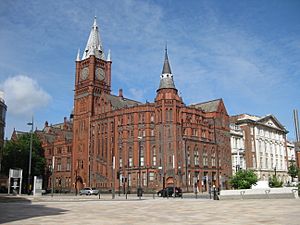
The North West is home to many universities, attracting students from all over the world.
- University of Manchester, Manchester – This is the largest single-site university in the UK.
- Manchester Metropolitan University, Manchester – Also one of the country's largest universities.
- UCLAN, Preston – The third-largest university in the region.
- Liverpool John Moores University, Liverpool
- University of Liverpool, Liverpool
- University of Salford, Salford
- Lancaster University, Lancaster
- The University of Law, Chester, Manchester
- Edge Hill University, Ormskirk
- University of Chester, Chester and Warrington
- University of Bolton, Bolton
- Liverpool Hope University, Liverpool
- University of Cumbria – The newest university in the region, with campuses across Cumbria, Lancashire, and London.
Over 60% of university students in the North West are from the region itself. Most of the other students come from the north of England.
Images for kids
-
Statue of John Lennon of The Beatles at The Cavern Club, Liverpool
-
Liverpool Anglican Cathedral, the largest religious building in the UK
See also
 In Spanish: Región del Noroeste de Inglaterra para niños
In Spanish: Región del Noroeste de Inglaterra para niños


